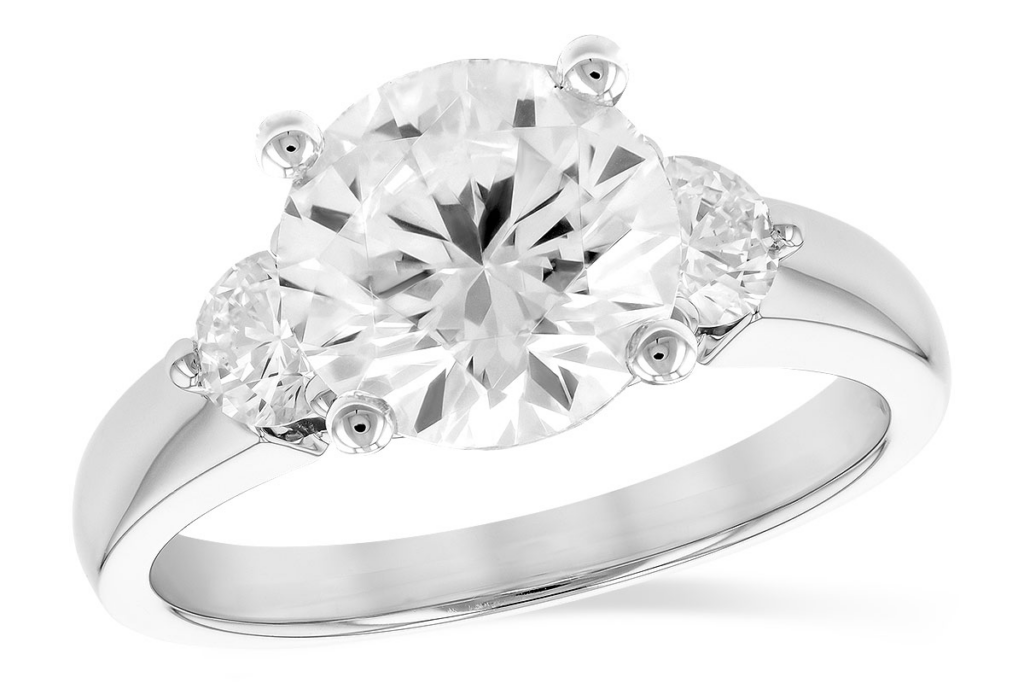Previously we have briefly discussed the different band styles for engagement rings. In this article, we will discuss in detail the different engagement ring settings (or band settings), along with the “anatomy” of an engagement ring, what to look for in a design – anything you need to know so you can buy or design the best engagement ring for your partner.
Anatomy of an Engagement Ring
Before we begin discussing the different designs, it is best to know the different parts of an engagement ring. Yes, even something as simple as an engagement ring has different parts. This knowledge comes in handy especially when designing or customizing an engagement ring, since this avoids confusion between you (and your vision) and the jeweler’s interpretation. (Plus, it does not hurt to sound like a professional when talking to one.)
The Basics
The classic engagement ring has 3 main parts:

- Head – which includes the diamond and the “container” of the diamond
- Shoulder – or the sides of the head (similar to our shoulder)
- Shank – the main ring itself.
The head of an engagement ring setting is where the design usually lies and can change depending on the cut of the stone, or the number of stones featured on the ring. This is also where different designs to secure a diamond are made.
A ring’s shoulder is the portion of the ring beside the head. When designing engagement rings, this is also one of the sections that is tailored. Different designs are available; the usual shoulder design is the same as the rest of the ring. You can have the shoulders tapered to make the stone look larger. Other designs shoulder designs have encrusted gemstones or have intricate designs. Customization is endless
Lastly, the shank of the ring is the main ring itself. The band can be a half-round shank, where the insides are slightly rounded so it’s a more comfortable fit. You can also have the insides flat, but do note that this is uncomfortable than the half-round shank.
While most of the shanks in the market are round, with a variety of designs, other shanks feature a flat bottom, also called the Euro shank. Some usually prefer this to keep the ring from spinning.
Now that we have handled, the basics, let’s discuss the different engagement ring settings.
Different Engagement Ring Settings, Band Designs, and Crown Styles
Band or ring setting refers to how the diamond is mounted or is held in place.
Solitaires and Tiffanies are the most common type of diamond settings in engagement rings. It allows maximum light exposure while holding the diamond securely in place.
There are other diamond settings to choose from. Depending on the design, it may increase or decrease the value of your diamond.
The Solitaire
As the most popular design, the solitaire features a classic, timeless, and minimal look. The reason it is called Solitaire is that it usually features one gemstone as its center stone. It may feature different setting designs.
Prong Setting
The prong setting is a claw-type design usually found in most engagement rings. This design allows maximum light exposure which makes the diamond shine brighter.


The prong of the crown usually has 4 to 6 claws that hold the center diamond in place. It is also used in conjunction with other designs such as cathedral, pave, or channel ring settings.
The number of prongs differs depending on the shape or cut of the diamond. Diamonds with four edges usually has four prongs. Heart shapes usually has three, and pear diamonds usually have five.
Tiffany Setting
The Tiffany is closely similar to the prong setting style, that it gives the diamond maximum light exposure. It has been said that the prong style is a copy of the Tiffany.
Bezel Setting
Bezel-set rings are diamond settings that wrap or frame the diamond completely. This is the most popular type of setting before the Prong/Tiffany came into popularity, as this setting holds the diamond or gemstone securely in place.


Bezel-type settings only apply to the Head of the engagement ring. Therefore, the shoulder and the shank may be as simple as a solitaire or may be customized depending on the design you have in mind.
Currently, Bezel setting can be a full-bezel design, or split or half-bezel where there are diamond is not fully covered and there are tiny openings at the top and bottom of the diamond.
Cathedral Setting
Cathedral-style engagement rings are gaining popularity once again, thanks to their intricate designs and endless customization options. This particular design was popular in vintage designs.


Cathedral style is a setting where the diamond and the setting (usually a prong-type setting) sat on top of the ring shank, known as the Bridge. It is called a Bridge since it serves as a bridge between the 2 shoulders of the setting. The shoulder extends up to, either the sides of the crown, or the gallery rail, forming arches that are found in cathedrals
Newer rings feature intricate in between the bridge and gallery rail. A perfect example is this 2-carat two-tone engagement ring.


This style makes the ring more pronounced, especially when viewed from the side.
Channel setting
Channel setting is a design where diamonds are placed in a “channel.”
This type of setting is usually popular in wedding bands, but modern engagement rings, usually in conjunction with other settings, feature this design.


The channel set is more commonly set on the Shank or the Shoulder of the ring rather than the head or crown. However modern designs feature the channel as a hidden halo, or as the design of the gallery rail.
Gypsy Setting
The Gypsy setting features the diamond in a flush setting and does not protrude. As a result, the shoulder gets thicker at the “head” or on top where the diamond is embedded. The flush design makes the surface smooth and seamless.


This design is more popular with men’s engagement ring or men’s wedding rings or where the gemstones are accent stones or side-stones to other designs.


Halo Setting
Halo setting is another popular style especially for center diamonds with smaller carats. Adding smaller diamonds around the center stone creates an illusion of a bigger diamond. The added diamonds also give additional sparkle to an already brilliant diamond.
A variety of the Halo, the Hidden Halo is where the diamonds are mounted on the side, as seen on the 2nd picture.


Halo ring settings can have different designs. One of the more popular designs combining it with a cathedral design where the shoulder holds or rests at the gallery rail where the diamonds are embedded.
Men’s engagement ring can also feature this design. It can be combined with a Gypsy setting as seen below:


Here is a women’s version of this stunning ring.


Three-Stone/Cluster Setting
The three-stone engagement ring is where you add two additional stones on each side of your center stone. It is gaining popularity since you can opt for other more affordable precious and semi-precious stones to add sparkle and character to an already beautiful engagement ring.
The three-stone engagement ring is said to symbolize the past, present, and future.


Three-stone engagement rings usually feature cathedral-style designs. The side stones are also mounted on the gallery rails and are connected to the ring by the shoulders.
Another variant of the multi-stone ring is the cluster setting. Instead of just putting two side stones, multiple smaller stones are added around the diamond. The added diamonds can be in a flush setting (Gypsy) or a Pave style
Pavé Setting
Pavé setting is another type where diamonds are “paved” and placed side-by-side in your metal band. Having a Pavé setting increases the cost of your diamond ring because of the additional stones embedded in your metal band.


It is usually added to the whole shank of the ring either on the outer side of the ring or along the sides.
Other Settings for your Engagement Rings and Wedding Bands
These are some of the best setting styles to choose from when buying or customizing an engagement ring. Other setting styles that are worth noting are the following:
- Tension – In this setting, the stone is held by the tension between the shoulders, making it appear that your stone is floating. A beautiful piece but while it provides the maximum amount of light possible, this is an expensive, and tricky style to master. The proportions must be exact to avoid the ring from falling or loosening. However, once perfected, it is truly a sight to behold.
- Tension-style setting – this is a design where the stone appears to be held by tension, but in-fact is secured in place, usually by a bezel or a prong, as seen below.
- Bar Setting – this design is similar to the Pave, but instead of enclosing the diamonds in all 4 sides, bar encloses it in 2 sides, as if there is a bar in between diamonds
- Split Shank – As the name suggest, the split shank is where the ring is split into two separate shanks.


The Best Setting Styles for your Diamond Jewelry.
There you have it! Here are the most common/popular engagement ring and wedding ring settings. But of course, customization is endless!
Check our gallery for more design inspiration, or call us or visit our showroom and let our experts help you design that one-of-a-kind engagement ring for your partner.



